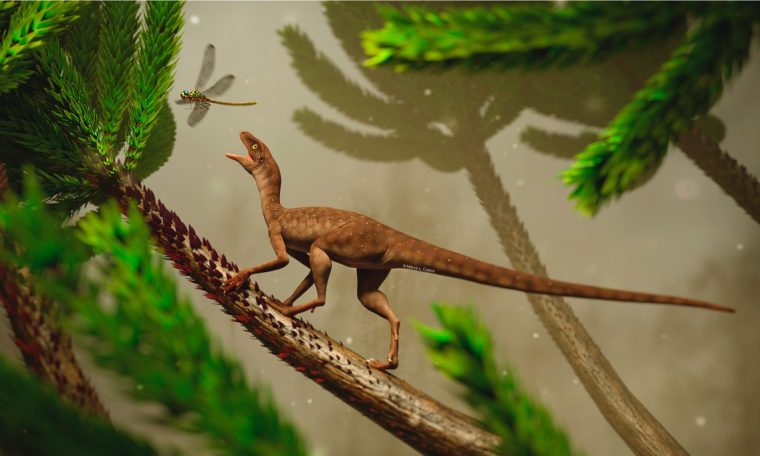
A study by Brazilian researchers published this Tuesday (3) in the scientific journal PeerJ clears up a confusion by identifying a new reptile, 225 million years old, whose fossils were found at the Linha So Luiz fossil site. Faxinal do SoternoIn the central area of Rio Grande do Sul: the Maheri Bonaparty,
Research reviews a small reptile called Faxinlipterus Minimus, from rocks of the Triassic period. It was described in 2010, assigned to the group Pterosauria, which includes the first vertebrates to have evolved active flight.
But the description is thought to be a fossil composed of bones from a postcranial skeleton and part of the skull (a jaw with teeth) found in two field expeditions, which diverged in 2002 and 2005.
Therefore, it was not possible to say with certainty that all the organs belonged to the same type of animal, even though it was accepted at the time that all bones belonged to the same species.
“Current knowledge of the fauna of the late Triassic indicates that the disparity of animals at that time was so great that animals found may at first glance resemble pterosaurs, but in reality are not. That’s what happened. Along faxinlipterus And maheri“, says Borja Holgado, a specialist in pterosaurs at the Institut Catal de Paleontólogia Mikel Crusafont in Barcelona, Spain, and currently a researcher at the Universidad Regional do Caryri in Serra.
Researchers identify a new 225-million-year-old Brazilian reptile – Photo: Marcio L. Castro / Illustracao
The new analysis made it possible to establish that there were, in fact, two separate species whose jaws would have belonged to another animal – based on a recent comparison with a new fossil found at the same site.
“the material on which faxinlipterus Based is too fragile and too incomplete. In addition, parts of the bones were covered with rock, which required more elaborate preparation”, explains Cesar Schultz. UFRGSAnd new research from another of the authors of a 2010 paper that has just been published.
Researchers identify a new 225-million-year-old Brazilian reptile – Photo: Rodrigo Temo Müller / Disclosure
The new fossil is composed of an incomplete skull whose maxilla exhibits the same characteristics as those attributed to the maxilla. faxinlipterusapart from parts of jawparts of a shoulder blade it is from vertebrae, So he can then be included in the description of the new fossil, which received the name Maheri Bonaparty,
“There has always been a great doubt whether the two specimens attributed to Faxinlipterus represent the same species, and whether it was a winged reptile”, comments pterosaur expert Alexander Kellner, who currently directs the National Museum. Huh. UFRJ,
When examining the specimen shortly after publication in 2010, Kellner noticed that several bones could be misidentified and lack clinical features of pterosaurs – among them, the distinctive features on the humerus (arm bone). Absence, such as a projecting crest. , which is characteristic of pterosaurs.
“In the original 2010 work, we verified that in the maxilla of the tooth are present faxinlipterus were widely separated, which is a characteristic of early Triassic pterosaurs. However, maxillary tomography showed that the teeth were not separated, as many teeth were lost in the fossil. With this, the pattern of the teeth and the next spacing between the alveoli [cavidades onde os dentes se inserem] did not correspond to pterosaurs”, highlights scientist Marina Soares.
Borja Holgado analyzed the material and agreed with the initial findings.
“It was clear to me that it was a primitive reptile that did not belong to pterosaurs, as it had no invariable characteristics of that lineage”, explains Holgado.
Researchers identify a new 225-million-year-old Brazilian reptile – Photo: Marcio L. Castro / Illustracao
degree of kinship and nomenclature
Using an anatomical database, the team of scientists established that faxinlipterus will be closely related to lagerpetids, a branch considered a sister group to Pterosauria in recent studies. Together, lagerpetids and pterosaurs form a broad group known as pterosauromorpha.
Thus, the new species Maheri Bonaparty was positioned as the most primitive member within the Pterosauromorpha.
“he is, faxinlipterus And maheri No pterosaurs are, though are related to, Specially maheri Researcher Rodrigo Müller explains that configs themselves as a key element in how the evolution of physical characteristics along the lineage of pterosauromorphs led to pterosaurs themselves being fully adapted for flight.
Researchers identify a new 225-million-year-old Brazilian reptile – Photo: Rodrigo Temo Müller / Disclosure
gender name comes from a new species maheriAn expression of the original Guarani-Caiva people, meaning “Who sees the sky”Being the most primitive of the pterosauromorpha, in an indication of its position in the evolutionary line of reptiles.
specific name A tribute to Argentina’s pioneering fossil vertebrate researcher, Jose Fernando Bonaparte (1928-2020)who died recently, and who actively worked with Brazilian paleontologists in the outcrops of Rio Grande do Sul, including the collection and description of several extinct vertebrates that lived during the Triassic period, including Huh faxinlipterus,
The publication is signed by 11 researchers from the Federal University Santa MariaFrom/to the National MuseumUFRJfrom the Regional University of Caryri, from the Federal University of Pampa, from the Federal University of Rio Grande do Sul and from COPPE/UFRJ,
Now, researchers are looking for new findings that help to understand how the first forms of this group suggested.
“These species, which have an estimated length of 30 cm faxinlipterus and for 40cm maheridemonstrates the importance of continuing to collect fossils in the region”.
Researchers identify a new Brazilian reptile that is 225 million years old – Photo: Marcio L. Castro / Illustracao



